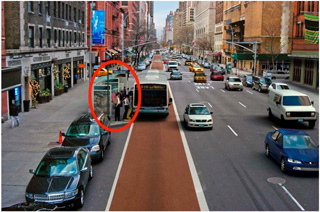Bus Rapid Transit Designs for East Side Avenues Still in Flux
Earlier this week DOT and the MTA showed plans for Bus Rapid Transit on the east side of Manhattan to the Seaport/Civic Center committee of Community Board 1. With implementation scheduled for next September, the question of how to allot space on First and Second Avenues is increasingly urgent. Robust bus improvements paired with protected space for biking on this corridor could become a model for sustainable street design in New York.
 An off-set bus lane, which DOT may or may not employ for BRT on the East Side. Image: NYCDOT [PDF]
An off-set bus lane, which DOT may or may not employ for BRT on the East Side. Image: NYCDOT [PDF]According to the Downtown Express, the presentation depicted "off-set" bus lanes — a configuration that puts the buses in an exclusive lane between other traffic and curbside parking. The bus station would be constructed on a sidewalk extension, so that buses don’t have to pull into and out from the curb. The effectiveness of this design depends in large part on keeping the bus lane clear of other traffic and double-parked vehicles. Bus-mounted enforcement cameras, which require Albany’s approval but were rejected by state lawmakers last year, would be absolutely necessary. A physically separated busway, however, wouldn’t need cameras to deliver significant improvements for bus riders.
I checked in with DOT to see if the off-set design has indeed been finalized, and the answer is "No." The agency is still considering different bus lane configurations. "An image we presented to the board on Tuesday night did show an offset lane," said a DOT spokesperson, "but this is a baseline design, one which we’ve used in presentations for the last six months."
An off-set configuration would give bus riders on the East Side a faster ride, but without a physically-separated busway, there are few certainties. Off-set bus lanes would have to be paired with camera enforcement to deliver the full potential benefits, said Walter Hook, director of the Institute for Transportation and Development Policy. Hook has advised several global metropolises on the implementation of Bus Rapid Transit.
If everything lines up and Albany does pass a law enabling the use of bus-mounted cameras, then, Hook estimates, total travel time on the M15 corridor could be reduced from 70 minutes to 48 minutes during peak hours using off-set lanes. Hook projects that a physically separated busway would cut that time to 42 minutes. No permission from Albany necessary.